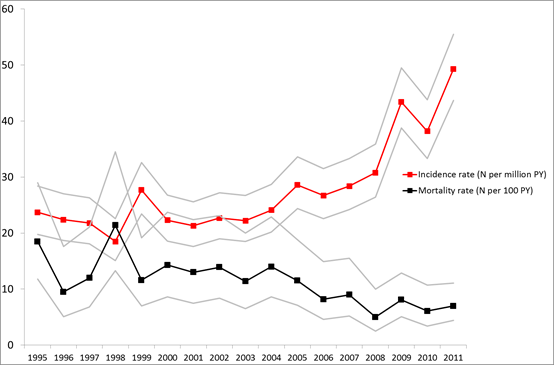Session Information
Session Type: ACR Poster Session A
Session Time: 9:00AM-11:00AM
Time Trends In Incidence And Mortality Of Systemic Sclerosis In Denmark From 1995-2011: A Nationwide Cohort Study
Background/Purpose: Epidemiological studies have documented an increasing incidence of several autoimmune disorders over the last few decades, but little is known about the temporal trends of systemic sclerosis (SSc). We aimed to improve our understanding of the epidemiology of SSc by evaluating over time the incidence and mortality in a registry-based nationwide analysis.
Methods: Using the Danish National Patient Registry (NPR) we identified all persons aged ≥ 18 with a first-time diagnosis of SSc (International Classification of Diseases 10th edition code M34 except for M34.2) between 1995 and 2011. Incidence rates (per million person-years) and first-year 1-year mortality rates (per 100 person-years) associated with SSc were calculated. Confidence intervals were estimated under the assumption of a Poisson distribution. Age- and sex-adjusted Cox regression models were used to investigate the association of SSc with mortality, compared with the background population.
Results: Within the total Danish population (spanning from 4.939.465 individuals in 1995 to 5.419.512 persons in 2011), the total number of unique SSc cases increased from 117 in 1995 to 267 in 2011. The mean age of onset remained unchanged throughout the study period; 54.2 years (range: 22.6- 85.6) in 1995 and 55.1 years (range: 18.5-98.6) in 2011. The proportion of women fell from 82% in 1995 to 75% in 2011. The incidence rate per 1,000,000 showed an increasing trend from 23.7 (95% CI 19.8-28.4) in 1995 to 49.3 [95% CI 43.7-55.5) in 2011. Similar trends were observed when stratified by sex and various age groups. The all-cause 1-year mortality rate per 100 person-years showed a decreasing trend from 18.5 (95% CI 11.8-29.0) in 1995 to 7.0 (95% CI 4.4-11.1) in 2011. The age and sex-adjusted hazard ratio compared with the background population fell from 16.4 (95% CI 10.5-25.6) in 1995 to 8.2 (95% CI 5.2-13.0) in 2011, respectively.
Conclusion: Our data show that the incidence of SSc was increasing and 1-year mortality rates falling during the study period. Mechanisms underlying our findings remain to be determined, but it cannot be excluded that the increasing incidence estimates may in part be explained by increased physician awareness and more sensitive ascertainment methods identifying earlier and less severe cases of SSc. This could possibly also explain a higher survival rate associated with SSc in recent years. Further studies are needed to investigate the mechanisms underlying our findings and furthermore outcomes on 5- and 10-year survival.
To cite this abstract in AMA style:
Butt S, Andersson C, Jacobsen S, Gislason G, Torp-Pedersen C. Time Trends in Incidence and Mortality of Systemic Sclerosis in Denmark from 1995-2011: A Nationwide Cohort Study [abstract]. Arthritis Rheumatol. 2016; 68 (suppl 10). https://acrabstracts.org/abstract/time-trends-in-incidence-and-mortality-of-systemic-sclerosis-in-denmark-from-1995-2011-a-nationwide-cohort-study/. Accessed .« Back to 2016 ACR/ARHP Annual Meeting
ACR Meeting Abstracts - https://acrabstracts.org/abstract/time-trends-in-incidence-and-mortality-of-systemic-sclerosis-in-denmark-from-1995-2011-a-nationwide-cohort-study/

